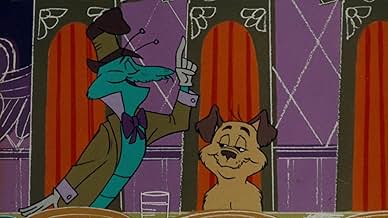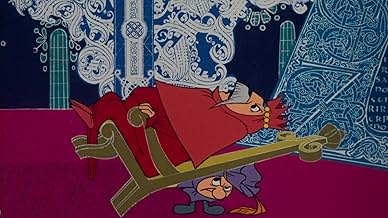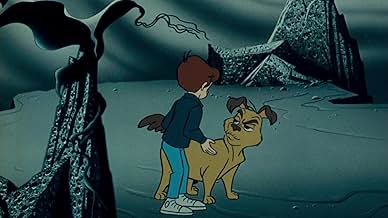VALUTAZIONE IMDb
6,7/10
3729
LA TUA VALUTAZIONE
Milo è un ragazzo annoiato dalla vita. Un giorno torna a casa e trova un casello nella sua stanza.Milo è un ragazzo annoiato dalla vita. Un giorno torna a casa e trova un casello nella sua stanza.Milo è un ragazzo annoiato dalla vita. Un giorno torna a casa e trova un casello nella sua stanza.
- Regia
- Sceneggiatura
- Star
Hans Conried
- King Azaz
- (voce)
- …
Daws Butler
- Whether Man
- (voce)
- …
Candy Candido
- Awful DYNN
- (voce)
June Foray
- Ralph
- (voce)
- …
Shepard Menken
- Spelling Bee
- (voce)
- (as Shep Menken)
- …
Les Tremayne
- Humbug
- (voce)
Michael Earl
- Friend
- (non citato nei titoli originali)
Chuck Jones
- Cable Car Passenger
- (non citato nei titoli originali)
Thurl Ravenscroft
- Lethargian
- (voce)
- (non citato nei titoli originali)
Recensioni in evidenza
Like Chuck Jones' earlier "Gay Purr-ee," this is a good film for those who are looking for something good, if decidedly different, in family entertainment. Mel Blanc, June Foray, Shepard Menken, etc., contribute their usual outstanding voice work (The scenes with Blanc as "Officer Short Shrift," especially, are a howl!), and the visuals, as one would expect from Jones, are consistently outstanding and imaginative.
Not that the film is without its' faults, by any means. The songs, by veterans Paul Vance and Lee Pockriss, range from the clever ("Don't Say There's Nothing to Do in the Doldrums," "Time Is a Gift") to the treacly ("Henceforth and Forthwith"). The moralizing, more pronounced here than it was in the original Norton Juster book, gets to be a bit heavy-handed at times. And, finally, Butch Patrick (Best known as "Eddie Munster" on "The Munsters") plays Milo, the central character, as such a whiney little jerk, at least in the beginning, that it's hard to work up much sympathy for him as the story goes on. Plus, even though he was still short for his age, there was no disguising the fact that he was, in every other way, a fast-maturing fifteen year old, and, thus, just a bit too old for the procedngs.
But, and I have to emphasize this again, don't let you stop you from seeing this movie. The result is more than the sum of its parts, and good, alternative family entertainment is what you get.
Not that the film is without its' faults, by any means. The songs, by veterans Paul Vance and Lee Pockriss, range from the clever ("Don't Say There's Nothing to Do in the Doldrums," "Time Is a Gift") to the treacly ("Henceforth and Forthwith"). The moralizing, more pronounced here than it was in the original Norton Juster book, gets to be a bit heavy-handed at times. And, finally, Butch Patrick (Best known as "Eddie Munster" on "The Munsters") plays Milo, the central character, as such a whiney little jerk, at least in the beginning, that it's hard to work up much sympathy for him as the story goes on. Plus, even though he was still short for his age, there was no disguising the fact that he was, in every other way, a fast-maturing fifteen year old, and, thus, just a bit too old for the procedngs.
But, and I have to emphasize this again, don't let you stop you from seeing this movie. The result is more than the sum of its parts, and good, alternative family entertainment is what you get.
I still don't get why so many people who have seen it dislike it so much. I first saw it when it was playing on Cartoon Network. I liked it so much that I had to get it on videotape. Granted, the moralizing was a bit heavy-handed, but all the same, I loved it when I was young and still find it entertaining now.
BTW: Those of you who did not like the movie may want to read the book. It is just as good, maybe better, but has things put better into perspective.
BTW: Those of you who did not like the movie may want to read the book. It is just as good, maybe better, but has things put better into perspective.
I very much enjoyed Phantom Tollbooth, a rare occurrence of the movie being worthy to the book. With weird music, great writing, and somewhat educational.
The plot of this film is that there's this boy named Milo. He leads a crappy life because he can't make up his mind about anything, when ever he's inside he longs to be out, and whenever he's outside he long's to in (that was from the book). Well one day he find's this strange box. In the box, there's a freaky tollbooth that talks. Then afterwards there's this car that shows up, he gets in the car and goes on his quest for happiness.
Even though it may seem like a acid trip when you see it, as the film goes on, you can tell that there's method to the madness. I would suggest this film to anyone.
The plot of this film is that there's this boy named Milo. He leads a crappy life because he can't make up his mind about anything, when ever he's inside he longs to be out, and whenever he's outside he long's to in (that was from the book). Well one day he find's this strange box. In the box, there's a freaky tollbooth that talks. Then afterwards there's this car that shows up, he gets in the car and goes on his quest for happiness.
Even though it may seem like a acid trip when you see it, as the film goes on, you can tell that there's method to the madness. I would suggest this film to anyone.
"What's to become of Milo?" That was the question posed by "Milo's Theme," the catchy pop tune co-written and produced by Lee Pockriss and Norman Gimbel, which opens Chuck Jones' 1969 film adaptation of Norton Juster's "The Phantom Tollbooth." I've seen the film myself, even during the early years of at least two of the Turner-owned networks: TNT and the Cartoon Network. But I want to take a moment to make these comments on Chuck Jones' Tollbooth because it has been, for the past decade or so, the result of a very special dream of mine. I'm Richard Washington, Founder and Chairman of Electric Pirates Entertainment. When I started EPE some fifteen years ago, one of the company's primary goals was to attempt a remake of the Tollbooth movie. Having seen it for myself, I knew a little something about the film's history. Metro-Goldwyn-Mayer had bought the rights to Tollbooth, along with Juster's second kids' book, The Dot and the Line, in around 1967; shortly thereafter, the management then in place at MGM assigned both properties to animation legend Chuck Jones, who by then was under contract to MGM. Basically, what management said to Chuck was: "Here are a couple of originals by Norton Juster. See what you can do about making one into a short subject; and the other into a 90-minute feature film." Essentially, Chuck did precisely what they'd told him to do. He not only made the short, bringing in actor Robert Morley to read the entire Juster text from The Dot and the Line, he also transformed "The Phantom Tollbooth" into a 90-minute feature --- i.e., an animated cartoon bookended by live-action sequences filmed on location in San Francisco, and starring Eddie Munster himself, Butch Patrick. This, I think, was Butch's last major starring role as a child actor. Once production on the Jones Tollbooth was completed and put in the can, the intent was to release Tollbooth, along with Dot & Line, at the 1969 Christmas season. However, the project somehow became involved in studio politics; the resulting double-bill was never given proper theatrical release until 1971 --- 2 1/2 years later, by which time MGM had fired all of its animation staff, including Jones. Thus what had been planned as MGM's first-ever animated feature ironically became the company's last-ever animated production. And that brings us to the part of this story concerning my very special dream: after having seen the Chuck Jones Tollbooth, I have spent the last several years tackling plans for a live-action, nonmusical remake of "The Phantom Tollbooth" --- in fact, I have actually spoken with Norton Juster himself about this! --- one that would basically correct the mistakes Chuck Jones had no doubt made when he filmed Tollbooth in late 1968. Mr. Juster has expressed his gratitude that I should want a new film version of his beloved book, but officially he has little to say on the matter in light of the fact that Chuck's 1969 film is, of course, part of the Turner Entertainment library. With that I have no quarrel. I'm simply saying that MGM should have waited for the magic of the movies to reach a sufficiently sophisticated stage in order to do proper cinematic justice to "The Phantom Tollbooth." That's why I have long believed that there are only two special effects powerhouses on the Planet which are capable of accomplishing such aims: namely, George Lucas' Industrial Light & Magic and Jim Henson's Creature Shop! With their combined expertise in computer-generated characters, animatronic effects, special make-up techniques and other way-cool elements, only ILM and the Henson Shop could truly make the magic of "The Phantom Tollbooth" come alive --- especially for what George Lucas once called that "generation [doomed to grow up] without fairy tales." And I have wanted nothing less than to be the man to make it all --- and I do mean ALL! --- possible. "But Richard," I sense you're asking, "did you like the movie itself?" Yes. Artistically, Jones' Tollbooth is a visual treat; and its clever motive of taking the concepts of Juster's Dictionopolis and Digitopolis to literal extremes provides the largest degree of 'eye candy.' The film does, sadly fall short by making the two Princesses, Rhyme and Reason, mere silhouettes; that, alas, denies the viewer the pleasure of seeing how beautiful they really are. Of course, considering that this is a Chuck Jones film, one cannot fault the voice talents! Mel Blanc, Daws Butler, June Foray and Les Tremayne were old friends of Chuck's during '67; their voices alone were and are worth the price of the video, if you will (that was for the Amazon.com customers out there!). Lesser-known vocals --- Shep Menken, Patti Gilbert, Candy Candido and Larry Thor --- are also in the cast, along with Hans Conried, in his first non-Disney cartoon voice role (I think). The 9-member ensemble clearly mold and shape Butch Patrick's role of Milo into what he ultimately becomes by story's end: an emotionally stronger, and, perhaps, a remarkably better boy --- but at least, a boy no longer bored by the world. Well, I think I've given you some kind of idea as to what you can expect from Chuck Jones' 1969 version of "The Phantom Tollbooth." Of course, if I can bring ILM and the Henson Shop together, set up a production homebase at London's famous Pinewood Studios (that's where they do the Bond movies), and then scout for locations in and around my beloved New York City, I think I can do for "The Phantom Tollbooth" what Sidney Lumet and designer Tony Walton tried to do for "The Wiz". I estimate that I should have it all coming together and released by .....oh, around the year 2008, or thereabouts. Here's hoping I can do it!
The Phantom Tollbooth is warped movie from the warped mind of the great Chuck Jones.
Milo, an ordinary boy, is bored with life. One day he receives a tollbooth as a present. This Tollbooth will supposedly take him out of his boredom.
Milo enters the Tollbooth and is instantly changed into a cartoon character. From here on in, he journeys to the "Whether" man, into the doldrums, meets tock, the watchdog, and onward to Dictionopolis and the Kingdom of Numbers in order to save Rhyme and Reason.
The movie is twisted in every which way; there are plenty of songs the make no sense but make you laugh out loud. The Animation is typical "Looney Tunes" style but works very well with the quirky plot.
The Phantom Tollbooth is a lost gem the deserves DVD treatment in the worst way. Lets hope one day soon that this diamond in the rough will find a new generation of children!
Milo, an ordinary boy, is bored with life. One day he receives a tollbooth as a present. This Tollbooth will supposedly take him out of his boredom.
Milo enters the Tollbooth and is instantly changed into a cartoon character. From here on in, he journeys to the "Whether" man, into the doldrums, meets tock, the watchdog, and onward to Dictionopolis and the Kingdom of Numbers in order to save Rhyme and Reason.
The movie is twisted in every which way; there are plenty of songs the make no sense but make you laugh out loud. The Animation is typical "Looney Tunes" style but works very well with the quirky plot.
The Phantom Tollbooth is a lost gem the deserves DVD treatment in the worst way. Lets hope one day soon that this diamond in the rough will find a new generation of children!
Lo sapevi?
- QuizNorton Juster, author of the book upon which this film is based, had no input on the adaptation, and many characters from the book weren't included in the film. He didn't like the film, and was angered by positive reviews.
- BlooperWhen King Azaz is first seen (in long shot) his costume has the purple and blue colors of the Mathemagician, instead of the correct colors of orange and red.
- Citazioni
Princess of Pure Reason: Never feel badly about making mistakes, as long as you take the trouble to learn from them.
Princess of Sweet Rhyme: Because often you learn more by being wrong for the right reasons...
Princess of Pure Reason: -than you do by being right for the wrong reasons.
- Curiosità sui creditiThe closing "THE END" zooms in as the last shot freezes into a still. The closing title (in one line) and "An MGM Picture" appear shortly before fading to black a second later.
- ConnessioniFeatured in Troldspejlet: Episodio #6.12 (1992)
I più visti
Accedi per valutare e creare un elenco di titoli salvati per ottenere consigli personalizzati
- How long is The Phantom Tollbooth?Powered by Alexa
Dettagli
- Data di uscita
- Paese di origine
- Lingua
- Celebre anche come
- The Phantom Tollbooth
- Luoghi delle riprese
- 420 Filbert Street, San Francisco, California, Stati Uniti(Garfield Elementary School at beginning of film)
- Aziende produttrici
- Vedi altri crediti dell’azienda su IMDbPro
Botteghino
- Budget
- 2.000.000 USD (previsto)
- Tempo di esecuzione1 ora 30 minuti
- Mix di suoni
- Proporzioni
- 1.85 : 1
Contribuisci a questa pagina
Suggerisci una modifica o aggiungi i contenuti mancanti





























